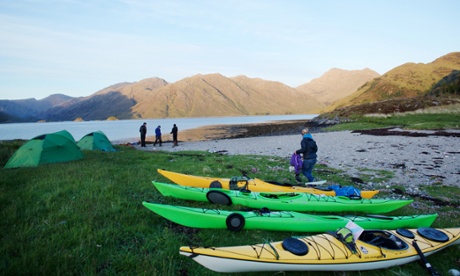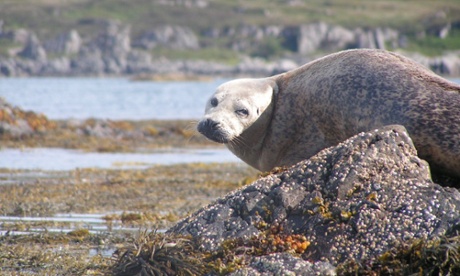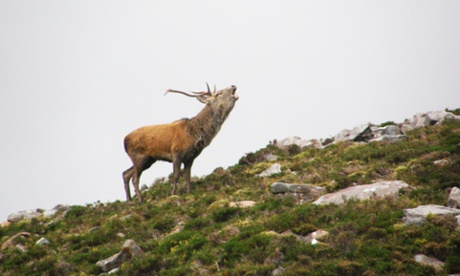
Michael Tait, The Guardian, July 8, 2015
We push our kayaks off the slipway for our first tremulous paddle up and down Loch Alsh, shores peppered with sprays of sea-pinks. The boats flush stalking herons and they launch themselves from the reed banks. A line of flotsam marks the point where currents meet and a scatter of gulls and terns take their pickings and gangs of Eiders skim their wing-tips on the surface.
There are four paddlers here in Kintail for five days of sea-kayaking on Scotland’s wild west coast with Erin, a Cornish water baby practically born in the surf and also a professional expedition leader. Only three hours on the water today and we’re back gliding under the bridge to Eilean Donan castle. The island was settled by a Celtic monk in 617 and has a bloody history of clan warfare and rebellion but it’s better known for its cinematic role, featuring in a slew of movies from James Bond to Highlander.
With day one orientation complete, and nobody capsized, we’re all cautiously encouraged but reminded of just how precarious we feel in those slivers of air and fibreglass. We unload the kayaks, cook and eat together and discuss the weather, the wind and the tides. It’s not quite the land of the midnight sun but even this early in the season I walk out at 10.30pm after dinner and it’s as bright as it was at 6pm.

Kayaks parked and tents pitched. Photograph: Rupert Shanks
The light is theatrical, freighted and atmospheric as if a storm were coming in. Pipistrelles, unusually visible, jink between the Downie Birches at the river’s edge. Above our base at the Kintail hostel a wave of mist is suspended on the crenellated saddle of the high ridge. Tomorrow we embark on a three-day expedition into Loch Hourn, the deep, fjord-like northern loch that borders the remote wilderness of Knoydart.
It’s a glorious day of bright sunshine, the van and fully-loaded trailer climbs up and over the dramatic Mam Ratagan Pass with it’s The Lord of the Rings-esque views north to Glen Shiel and back to Kintail. As we drive by, a tiny Roe fawn appears fleetingly, sun-dappled and blinking in a forest clearing. We drop down into the lush, deciduous valley of the Glenelg peninsula with its views to Skye, Eigg and Rùm and follow the coast road as far as it goes to Corran, unload, pack the boats and carry them down to the shore.
Loch Hourn is surrounded by a spectacular amphitheatre of rugged mountains and opens onto the Sound of Sleat with views to Broadford in Skye and the alpine-like shards of Skye’s famous Cuillin range beyond. Skirting the tiny islands at the mouth of the loch, we glide over its glassy surface. The water is clear to 20ft and beneath us an aquatic forest of marine sea grass, dun bladderwrack, purple dulse and thick ribbons of emerald kelp sway and billow from their hold-fasts.

Rock on … a seal relaxing. Photograph: Rupert Shanks
Inquisitive seals pop their heads out of the surf, twitch their whiskers at us, watch curiously for a while then flop back into the water. We’re in their element, no threat, just unusual primary-coloured sea creatures. Suddenly, and obligingly, a 10-pointer stag frames himself majestically on the headland and we fiddle to focus our cameras before he plops down in the heather.
As Erin puts it, we “bimble” along the edge of cliffs where the sealife clings and gathers and there are hundreds of moon jellyfish, shoals of cloud bellows, drifting marine phantasms and phosphorescent pink sea stars that writhe and convulse on the rocks. We gather a few mussels and whelks from the rocks and carry them in little piles on our spray-decks.
That night we camp on Eilean Muinean, a tiny spit with 360-degree views around the crucible of Knoydart’s wild crags, and push the mussels delicately into the edges of our driftwood fire to poach in their juices and hinge-open slowly to reveal delicious little smoky jewels. I dive into the freezing loch to cast-off the hot hours working in the boat– it’s good for a douse but too cold to swim for long. A ringed plover is settled on her eggs in a little scrape in the pebble beach and we tiptoe around her to eat. Wind, sun and six hours of paddling take their toll and we peel off one by one into the tents to sleep as deeply as the occasional shrieking Arctic Tern will permit.
The wind is up in the morning, eddies spin the kayaks around on spiralling columns of water, currents make us aquaplane. We’re skating suddenly on black ice, veering off-course. We drop our skegs, little fins that stabilise the boats, and wrestle beyond the swirling cauldron to enter a flat calm bay, the mountains, cliff and forest above mirrored on the water’s surface. I’m leading and the bow barely disturbs the reflection. Suddenly I have the vertiginous feeling that I’m upside down. Is the water above me? Am I paddling through the cliff, through the mountain, among the trees?

Mam Ratagan Pass. Photograph: Michael Tait
As we approach our final landing point, someone cries out and we spin to see a pod of porpoises cresting no more than 8 to 10 metres from us. We sit, paddles up, rapt for 10 minutes as they arc around us, blowing and diving, making their way up the deep channel into the loch.
A shocking pink and deep purple tunnel of rhododendron blooms kaleidoscope past the van on the road into Plockton. Everyone’s windswept, sunburned and aching after four days’ paddling but langoustines and fish from the loch await, as well as local cheese and beer. We’re all in high spirits, the expedition has been a waking dream, more dimensional and invigorating than any of us could have imagined. Erin asks what had been our highlight so far and everyone murmurs quietly, as if saying it out loud might dispel the truth of it, “porpoises”.

Call of the wild … a stag on the headland. Photograph: Rupert Shanks
It’s our last day, the most challenging. We’re crossing the bridge to Broadford in Skye and we’ll paddle the Sound of Sleat, the body of water between the island and the mainland. There are 20mph south-westerly winds predicted, strong tides and currents, easy by a seasoned kayaker’s standards but at the edge of our limits. We drop in and coast the first few miles, practising turns and speed-work in the bays to the familiar amused audience of craning seals. An otter tumbles and basks in the kelp and we sit watching the delightful dance until we can no longer distinguish her from the weed.
We’re out in the channel now and near the rocky headlands, the peaks are four feet high, there’s backwash and strong currents to contend with. The waves broadside the boats in the turns and the alarming lateral motion threatens to tip us into the Sound. I find myself constantly stabilising with the paddle but I’m making slow progress. It’s nerve-wracking and I feel certain I’ll pitch in. Erin calmly sidles her boat up to me and says: “You’re doing fine, keep paddling strongly.” It’s good advice; I paddle hard, correcting the drift and finally we get around the third headland and onto the wind- and tide-driven waves.
We’re turbo-charged now and propelled across the bay on great surges of power, surfing the waves onto our final soft and sandy shore. I realise the sea only permits collaboration, there are no solo artists out here. There’s a relationship to be had and we’ve only just been introduced. I’m reminded of the famous last line of Casablanca: “Louis, I think this is the beginning of a beautiful friendship.”
• The trip was provided by Wilderness Scotland (01479 420020, wildernessscotland.com). The five-night West Coast explorer costs £775, staying in hostels or wild camping, depending on weather, and including all meals, guide, equipment and transport from Inverness railway station. Departures include 22 August 2015, and 11 June, 16 July and 20 August 2016
This article originally appeared on guardian.co.uk
This article was written by Michael Tait from The Guardian and was legally licensed through the NewsCred publisher network.
![]() https://images3.newscred.com/cD1jMDY5MGZkNDEwNjM3N2E4YTlmZGUxZDNjODcxZGVhMSZnPThmYjVkMjE1OWRiMWY1Njc4OGE3MWQ5YTFiN2QwNmI2
https://images3.newscred.com/cD1jMDY5MGZkNDEwNjM3N2E4YTlmZGUxZDNjODcxZGVhMSZnPThmYjVkMjE1OWRiMWY1Njc4OGE3MWQ5YTFiN2QwNmI2